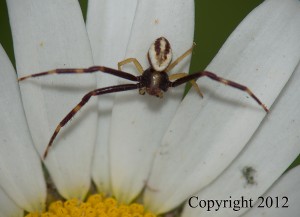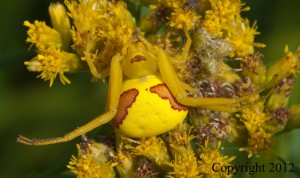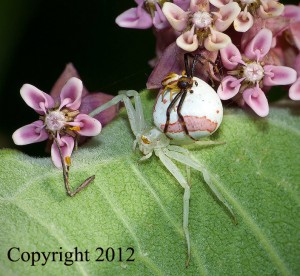I recently photographed what I thought was a different species of spider only to discover that it is a male Goldenrod Crab Spider (Misumena vatia). The male’s body is quarter the size of a female and they often hide on the underside of leaves. They feed on insects (sometimes ones that the females catch) or nectar.
Crab Spiders get their name because they resemble seashore Crabs. Their front two pairs of legs are much longer than the back pairs and they often move sideways on a flower in a crab-like manner. They do not spin webs but hunt by sitting still, camouflaged on a flower, waiting for insects and grabbing them with those long front legs. They have excellent eyesight and must be approached carefully to avoid startling them.
Individuals change color (slowly over a few days) to match the flower they are hunting from. Their color palette is white, yellow, and rarely pale pink. Red, blue, and purple are outside of their range. Studies show that the coloration does not correlate with hunting success. White spiders have the same success rate on white, yellow, or even blue flowers (See Brechbuhl, Casas, and Bacher).
The presence of Crab Spiders on flowers does change the pollinators that visit the flowers. Smaller bees avoid flowers inhabited by spiders but visits from larger Bumblebees are unaffected. It is presumed that the larger bees are not preyed upon by the spiders (See Dukas and Morse).
Although Crab Spiders spin no web, they still produce silk. It is used as a drop line to escape predators and to cover egg sacs. They hide egg sacs, attaching them by silk to the underside of a leaf and then wrapping the leaf around the egg sac to protect it. The baby spiders are mini-copies of the adults and go through several molts before reaching mature size. Immature spiders overwinter and it is bizarre to see them on a warm day walking on the snow.
If you want more information on spiders, consult Larry Weber’s excellent book Spiders of the North Woods, part of the North Woods Naturalist Series. It is published by Kollath+Stensaas Publishing.
Works Cited
Brechbuhl, Rolf, Jerome Casas, and Sven Bacher. “Ineffective Crypsis in a Crab Spider: a prey community perspective.” Proceedings of the Royal Society 277 (2010): 739-746. Web.
Dukas, Reuven, and Douglass H. Morse. “Crab Spiders Affect Flower Visitation by Bees.” OIKOS 101 (2003): 157-163. Web.
Weber, Larry. “Spiders of the North Woods.” Duluth: Kollath+Stensaas Publishing, 2003. Print.



